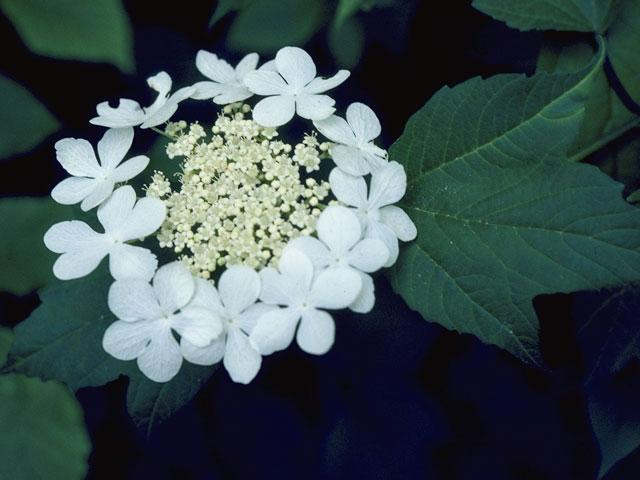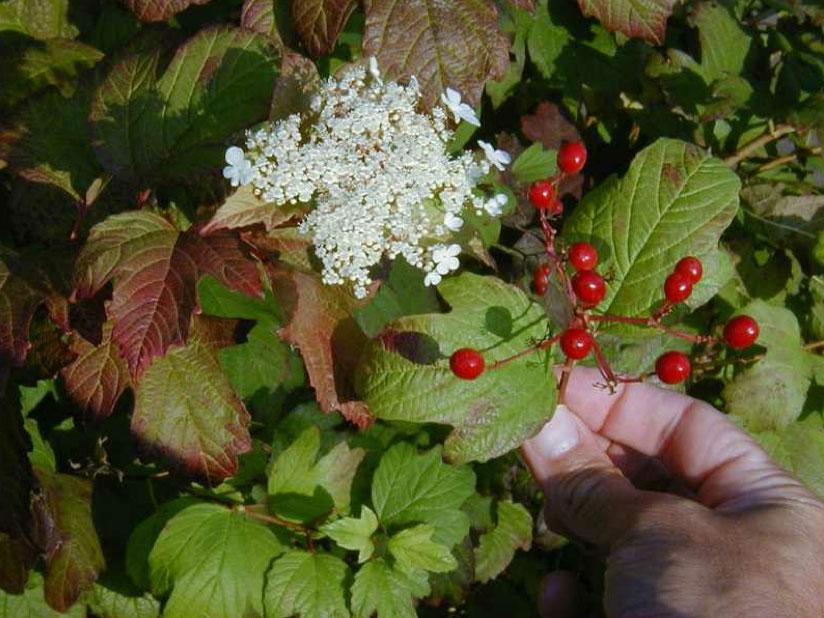American Cranberry Bush
Viburnum trilobum 是一种美丽的灌木,生长着小而可食用的红色浆果和白色的花朵吗 bloom.
Scientific Name: Viburnum trilobum (syn. Viburnum opulus var. Americanum)
Common Name: American Cranberry Bush; Mooseberry; High Bush Cranberry; American Cranberry Bush
Viburnum, Cranberry Viburnum
Plant Family: Adoxaceae (Moschatel Family)
Etymology: Viburnum opulus comes from the Latin word viburnum (“wayfaring tree”) and opulus which comes from the Gaulish word opolos (“maple”). “Var. Americanum” 是用来区分这种植物来自美洲的拉丁短语Viburnum opulus has a European form).
Indigenous Uses
美洲原住民,特别是Ojibwe (Chippewa)部落,使用可食用的浆果 both as a food and for its medicinal properties. Viburnum opulus var. Americanum 在冬季食用,因为它含有大量的维生素C 烘烤成食品,如蛋糕,或干燥,并添加到调味品或糖浆. The 根也被注入用于某些医疗问题,如脱垂 子宫和其他妇科问题. Ojibwe部落经常使用这种浆果 作为诱捕兔子的诱饵.
Edible Parts
The berries of the Viburnum opulus var. Americanum 植物的主要可食用部分是什么. 虽然不应该在里面吃 由于其毒性轻微(大量服用可能导致胃部不适), 它们可以生吃,也可以煮成果酱和果冻. They are best to be eaten when 成熟,在第一次冷冻之后,因为它们在这段时间里往往有一种更甜的味道. 通常,经过多次冷冻后,浆果会枯萎并有苦味. The 枫树状的叶子也可以用来泡茶. The white flowers can be added into 甜点,以增加甜度和食用装饰.
Gathering and Using
通常,高丛蔓越莓所在的地方有大量的 周围的植物和浆果. 为了达到最佳口感,浆果应该 在第一次霜冻之后收集,最好是在清晨. In order 为了制作蜜饯、果酱和果冻,需要收集大量的浆果 因为浆果通常只有12毫米. 还应观察植株是否有蚜虫 白粉病可能意味着不应该食用的疾病或细菌. 浆果挂在植物的树枝上,可以摘下来. After cleaning 浆果可以生吃,也可以煮熟吃. The leaves can be boiled or steeped in cold water for tea. 这种花通常被用来给食物添加甜味.
永续农业的功能和注意事项
药用,高浓度的维生素C,是食物的重要来源 野生动物,侵蚀控制,防风林,景观美化,美学,和营养丰富的食物 for humans. 常用作屏障和景观的边界. Also, they are 被认为是冬季生存的食物,因为浆果会留在雪上面,而且经常 taste better after freezing.
Habitat
你可以期待美国蔓越莓灌木生长在潮湿的土壤和排水良好 在部分荫凉至阳光充足的地区壤土. 尽管它在这样的条件下茁壮成长, 只要土壤不干旱,它也能在排水不良的土壤中生存.
How to Identify
美国蔓越莓灌木是一种大而茂密的灌木,可以从8-12英尺高不等 and has a spread of 8-12 ft. 叶片3裂,深绿色,与叶片相对 类似枫叶的外观. 秋天的时候,树叶是红色的. 花期从4月下旬到7月,白色的花边花可以 在灌木上发现,花的外圈较大,内圈较小 flowers. 浆果,在九月和十月成熟,并保留整个季节 冬天,有类似蔓越莓的外观,但几乎是半透明的时候 ripe. 蔓越莓丛也有一种欧洲品种(Viburnum opulus) that is invasive in the U.S. and very similar to Viburnum opulus var. Americanum. 这种形式有不可食用的果实,与美洲形式形成鲜明对比 腺体(叶柄与叶片连接的地方)向内弯曲,而美洲的 形态有向外突出的叶柄腺体.
 Bransford, W.D. and Dolphia. Wildflower Center Slide Library. April 1994.
Bransford, W.D. and Dolphia. Wildflower Center Slide Library. April 1994.

Missouri Botanical Garden, Accessed February 18, 2022.
Wildlife Support
美国蔓越莓丛是野生动物的重要食物来源,包括鸣禽, gamebirds, and small mammals. 灌木的果实被许多鸟类吃掉 如雪松,知更鸟和隐鸫. 它也可以作为寄主植物 蝴蝶和飞蛾的幼虫,尤指春天青(Celastrina ladon). 白花盛开时吸引传粉者.
Additional Information
美国蔓越莓丛通常与掠食性昆虫有共生关系. 它的叶茎上的腺体产生甜美的花蜜,吸引昆虫 as wasps, ants, and some flies. 这些昆虫保护植物不受有害毛虫的侵害 在采集花蜜的同时捕食其他昆虫.
Sources
- Arbor Day Foundation. “American Cranberrybush Viburnum.” arborday.org. Accessed February 18, 2022.
- Armstrong, Charles. 高丛蔓越莓(不是真正的蔓越莓).” University of Maine. Cooperative Extension: Cranberries. Accessed February 18, 2022.
- Beadle, David; Leckie, Seabrooke. 彼得森北美东北部飞蛾野外指南.
- Gilmore, Melvin R., 1933,“植物的一些奇帕瓦用途.” Native American Ethnobotany DB. Ann Arbor. 密歇根大学出版社,第141页.
- Levine, Carol. A Guide to Wildflowers in the Winter.
- Petterson, Lee Allen. 北美东部和中部可食用野生植物野外指南.
- Sweet, Hannah. 《美国蔓越莓丛的故事.” Eat the Planet, February 2021.
- The Morton Arboretum. SEINet Arizona-New Mexico Chapter. “Viburnum opulus var. Opulus.” org. Accessed February 19, 2022.
- TWC Staff. Lady Bird Johnson Wildflower Center. University of Texas Austin. “Viburnum opulus var. Americanum.” org, September 2016.
- USDA NRCS Plant Materials Program. USDA NRCS. “American Cranberrybush Fact Sheet.” Plants.usda.gov, February 2002.